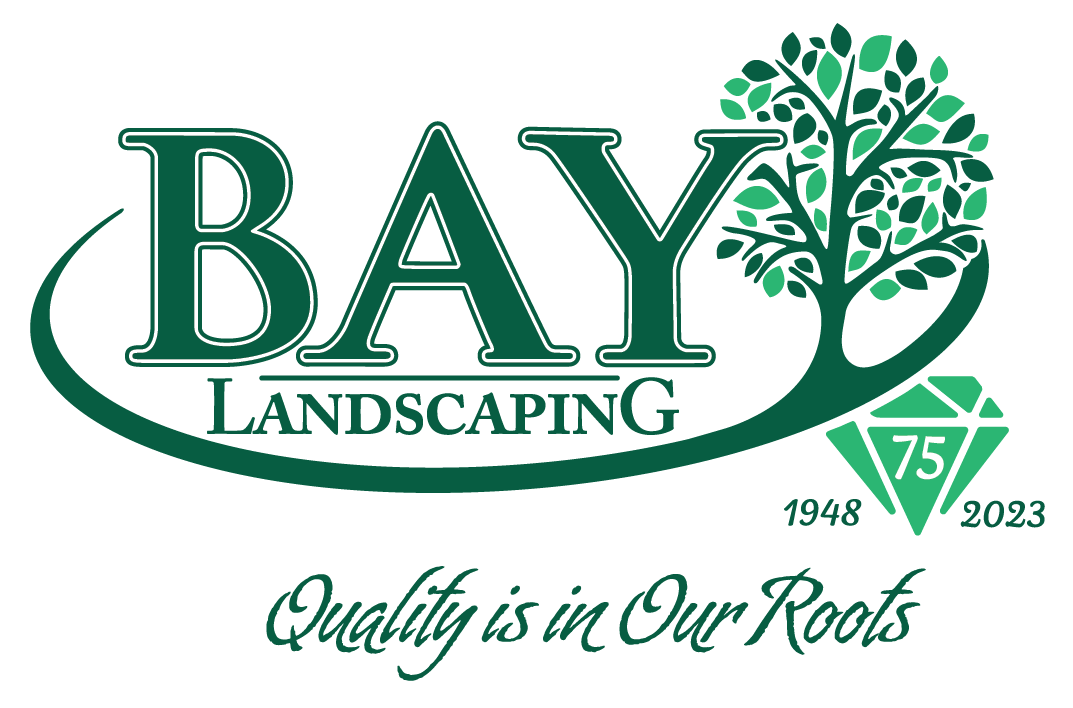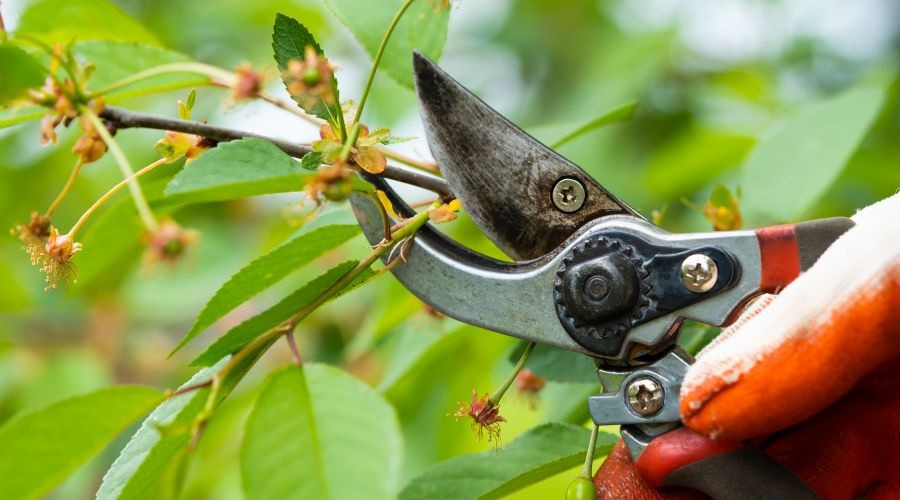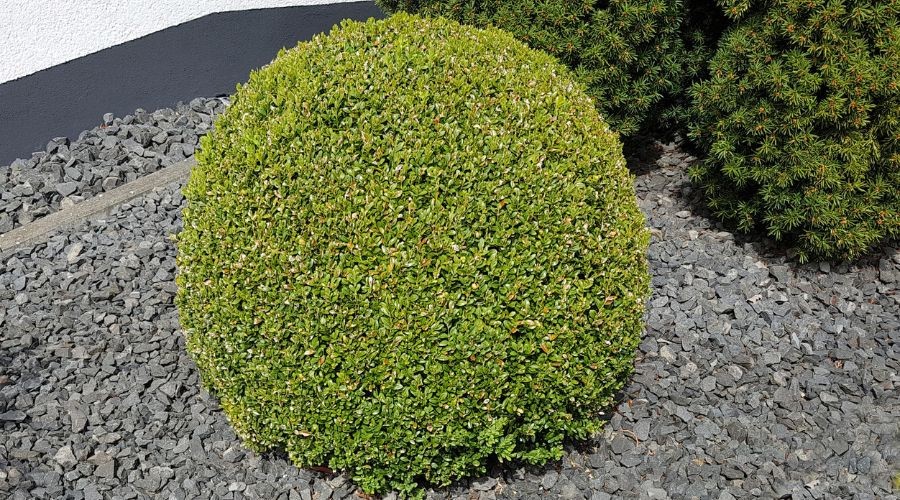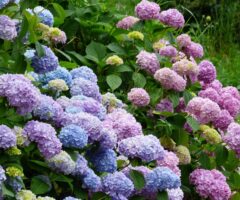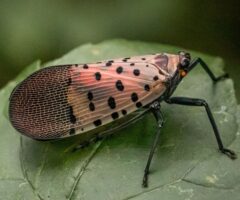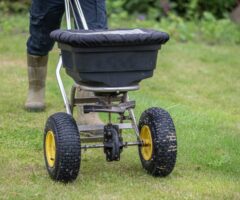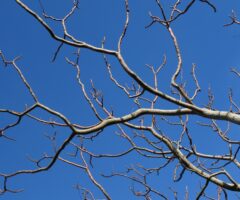Pruning is one of the most important aspects of plant care, yet it remains one of the most misunderstood. Every year, well-meaning homeowners take their electric or gas-powered shears and shape their shrubs into boxes, balls, or cones, thinking they’re doing their landscape a favor.
While this approach might create a tidy look in the short term, year after year of shearing your trees and shrubs like this can age your plants prematurely, compromise their health, and strip them of their natural beauty.
Gardens thrive when plants grow together naturally, filling spaces with greenery that changes with the seasons. But because pruning is often misunderstood, many landscapes default to tightly sheared shapes, neatly spaced in mulch. There’s nothing wrong with that look, but it’s not the only option. Let’s explore some better ways to shape a garden.
Key Takeaways:
- Early spring (while the plant is still dormant) is the perfect time to encourage fresh growth and set your trees and shrubs up for a strong growing season.
- Pruning at the wrong time can mean fewer flowers – spring bloomers (plants that flower in the first part of June or earlier) should be pruned after they flower, while summer bloomers and most evergreens do best with a dormant or early spring trim.
- Over-pruning, topping, and constantly shearing plants into tight shapes weakens them over time, making them more prone to stress and even disease.
- Dull or dirty pruning tools can make messy cuts that make it harder to prune properly – always use sharp, clean tools.
- Good pruning is not about cutting as much as possible – it’s about making the right cuts in the right places to keep your plants healthy and looking their best.
- Proper pruning will enhance the four “F’s” of plant selection – flower, fruit, foliage, and form.
Why Spring / Dormant Pruning Is Important
As plants emerge from dormancy, pruning helps them establish strong, healthy growth throughout the season. Dormant/early spring is ideal for structural pruning and plays an important role in fine-tuning a plant’s health and appearance.
Here’s why spring pruning matters:
- Encourages Healthy Growth: Trimming back dead or weak branches allows the plant to redirect energy toward vigorous new shoots, leading to a fuller, stronger tree or shrub.
- Boosts Flower and Fruit Production: Certain trees and shrubs bloom and produce fruit on new growth. Pruning at the right time helps the plant put its energy into producing more flowers, bigger and brighter leaves, and better quality fruit.
- Prevents Overcrowding: Thinning dense growth improves sunlight penetration, and allows room for vigorous new growth.
- Maintains Shape and Structure: Left unchecked, some plants can become overgrown or misshapen. Pruning helps maintain their natural shape and form.
Common Mistakes to Avoid When Pruning Trees and Shrubs in the Spring
Here’s the thing about pruning – it seems simple, but it’s surprisingly easy to get wrong. Proper pruning is a skill, and like any skill, it takes some time to perfect. Below are some of the most common mistakes homeowners make when trimming their trees and shrubs and how to avoid them.
1. Pruning at the Wrong Time
Timing is everything when it comes to pruning, and different plants have different needs. Cutting back at the wrong time of year can mean fewer blooms.
- Spring-blooming shrubs and trees (such as lilacs, azaeleas, and magnolias) set their flower buds in late summer or fall. Pruning them in late summer, winter, or early spring removes those buds and reduces flowering. The best time to prune them is immediately after they finish blooming, so they have time to develop next year’s buds.
- Summer-blooming plants (like roses and spirea) bloom on new wood. These should be pruned while dormant in early spring before new growth begins to encourage strong flowering. Summer blooming plants start their bloom cycle here in mid-Michigan around the 2nd week in June. If it starts blooming in or after the 2nd week of June, it’s probably a summer bloomer.
If you prune at the wrong time, don’t worry – your plants won’t die. You might just miss out on blooms for the season. If your shrub is overgrown and needs rejuvenation, the best time to trim is during dormancy or early spring. But be careful – some plants can’t handle heavy pruning, while others thrive when cut flush to the ground.
2. Ignoring Plant Structure
One of the biggest pruning mistakes people make is repeatedly shaping plants into unnatural geometric shapes – like perfectly rounded shrubs or squared-off hedges. Instead, use selective pruning techniques to maintain the plant’s intended form while still promoting strong, healthy growth.
Having a formal sheared hedge is fine, but from time to time, some thinning will extend the life of your plant for years.
3. Using the Wrong Tools
If you’ve ever used dull or dirty pruning shears, you know how frustrating it can be. Poorly maintained tools don’t just make the job harder – they also create rough, jagged cuts that leave plants longer to heal.
- Use sharp, clean tools to ensure smooth cuts that allow plants to heal quickly.
- Disinfect pruning tools (especially between cuts when working on diseased plants) to prevent spreading infections. A simple solution of rubbing alcohol or diluted bleach works well.
- Choose the right tool for the job – hand pruners for small branches, loppers for medium branches, and a pruning saw for larger limbs.
4. Over-Pruning
It’s easy to get carried away when pruning an overgrown tree or shrub, but removing too much at once can cause growth in places you don’t want. Over-pruning weakens a plant, reducing its ability to photosynthesize and store energy.
When pruning trees, be sure not to remove more than 1/3 of the top in any one year. If you do, it is likely to form water sprouts (long, straight shoots from random spots) that will be removed. Thus, wasting resources by not directing growth to the desired areas.
In shrubs, these water sprouts may be desirable when rejuvenating an old shrub.
5. Over-Shaping
Constantly shearing shrubs into tight shapes might seem like a quick way to keep things tidy, but over time, it leads to weaker plants, higher maintenance, and a less natural-looking landscape.
Each species has its own unique growth pattern and form. For example, burning bush naturally grows in a vase shape, while boxwood has a more rounded form. When you fight against these natural patterns, you’re creating unnecessary work and stress for both you and your plants.
By pruning in a way that supports a plant’s natural shape, you’ll make maintenance easier, keep trees and shrubs healthier, and create a landscape that thrives with less effort.
6. Topping Trees
Topping is when you cut back large branches or the upper canopy of a tree to reduce its height. While it might seem like a quick way to control size, topping weakens the tree encourages weak regrowth, and makes it more vulnerable to storm damage. Instead of topping, opt for crown reduction pruning, which selectively removes branches while maintaining the tree’s natural structure.
Or maybe consider removal and replacement of a plant that will stay in bounds with little or no pruning at all.
7. Flush Cutting Branches
Many people mistakenly cut branches flush against the trunk, removing the branch collar – the swollen area at the base of the branch that is considered the tree healing zone. Flush cuts prevent proper healing, leaving the tree vulnerable to decay. Instead, always prune just outside the branch collar to allow the tree to close the wound naturally.
8. Leaving Stubs
On the other end of the spectrum, some homeowners don’t cut close enough to the branch collar, leaving behind stubs, or short sections of deadwood, that don’t heal properly. These stubs can spread decay deep into the tree. Always make clean cuts just above the branch collar.
9. Over-Shearing Shrubs
Constantly shearing shrubs into tight, artificial shapes (like boxes or balls) can weaken them over time. This repetitive cutting removes the outermost growth, preventing sunlight from reaching the interior branches, leading to bare centers. Instead, use selective thinning cuts to maintain shape while preserving the plant’s natural structure and promoting new interior growth.
10. Neglecting Young Trees
Many people wait until a tree is large and problematic before pruning, but early training is one of the most effective ways to ensure a tree grows with a strong structure. Light pruning on young trees helps prevent future issues, like weak branch attachments or uneven growth.
The most important pruning happens from the time a tree is planted until its trunk reaches 6-8 inches in diameter – about the size of a volleyball.
Learn How to Prune the Right Way with Bay Landscaping
Pruning doesn’t have to be intimidating! If you’re ready to learn the best techniques for keeping your trees and shrubs healthy and beautiful, join us for our next spring pruning class. Our experts will show you exactly how to prune correctly, preserve natural plant forms, and avoid the most common mistakes.
Our next Pruning Seminar will be Saturday, March 22nd from 10am – 1pm. The location is still to be determined.
Join us for a crash course in pruning! Whether you’re new to plant care or you’re an experienced gardener, we will have great tips, tricks, and information for beginners and master gardeners alike.
The first part of the seminar will be instruction and Q&A. Then, we will take our knowledge outdoors to practice our pruning.
This event is free but BYOT – bring your own tools. If you wish to partake in the workshop portion of the seminar, be sure to have your pruning shears with you. As a portion of this class is outside, please dress accordingly for the weather.
PLEASE RSVP by calling our office 989-893-0000, messaging on any of our social media platforms, or emailing info@baylandscaping.net.
When you register, please provide us with a means to contact you so we’re able to update you when the location has been determined.
To stay up-to-date on our latest workshops, expert tips, and seasonal landscaping advice, sign up for our newsletter today.
